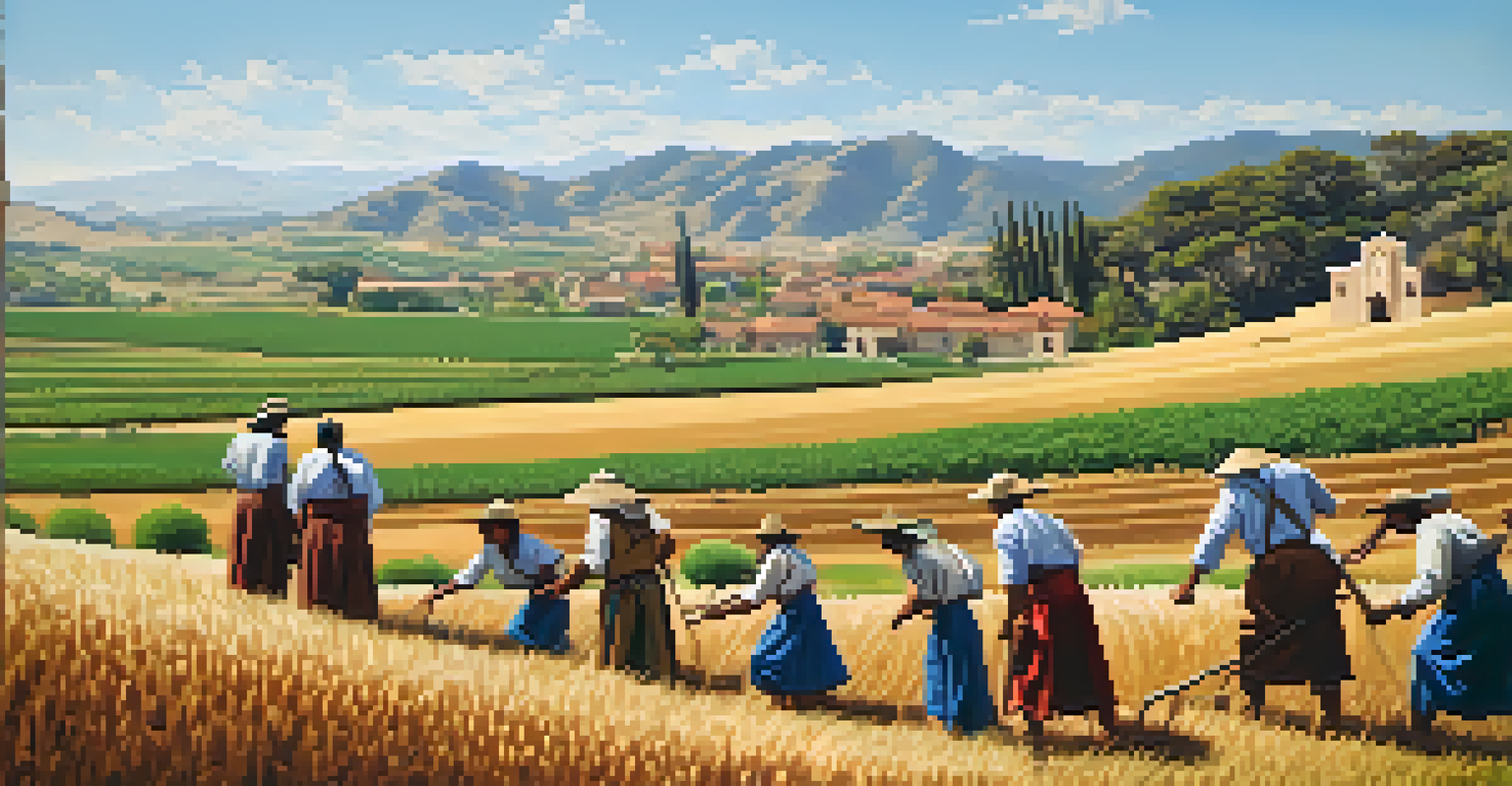The Role of Spanish Missions in California's Native History

Introduction to Spanish Missions in California
Spanish missions were established in California during the late 18th and early 19th centuries as part of Spain's colonization efforts. These missions aimed to spread Christianity among the Indigenous populations and secure Spain's territorial claims. The first mission, Mission San Diego de Alcalá, was founded in 1769, marking the beginning of a significant cultural and historical shift in the region.
The colonization of California not only disrupted Indigenous ways of life but also imposed a new cultural framework that shaped the future of the region.
The missions were not just religious centers; they became hubs of agricultural development and community life. Each mission was typically situated near a water source and was designed to support the local Indigenous population. This dual role as both a spiritual and economic center created a complex relationship with the Native peoples.
While the missions provided some resources to Indigenous communities, they also imposed foreign values and disrupted traditional ways of life. Understanding this duality is essential to grasp the broader implications of the missions on Native history in California.
The Goals of the Mission System
The primary goal of the Spanish mission system was to convert Indigenous people to Christianity. Missionaries believed that by introducing Catholicism, they could 'save' the souls of Native Americans, who they viewed as living in spiritual darkness. This belief often overshadowed the Indigenous people's own religious practices and beliefs.

In addition to religious conversion, the missions aimed to integrate Native Americans into Spanish colonial society. This involved teaching them European agricultural techniques, crafts, and languages, which were often enforced through strict discipline. Consequently, this cultural assimilation had lasting effects on Indigenous identities.
Missions Aimed to Convert Natives
Spanish missions sought to convert Indigenous peoples to Christianity while integrating them into colonial society.
The economic ambitions of the mission system were significant as well. By cultivating crops and raising livestock, missions sought to create self-sustaining communities. However, this often came at the expense of traditional land use and practices among Native populations.
Impact on Native Populations
The establishment of missions had a profound impact on Native populations, both positively and negatively. On one hand, some Indigenous people gained new skills and access to European goods. On the other hand, many were subjected to harsh labor conditions and forced assimilation, leading to a loss of cultural heritage.
Cultural exchange is often a complex dance of resistance and adaptation, revealing the resilience of those who endure.
Disease played a critical role in this transformation. Many Native Americans had no immunity to European diseases, which led to devastating outbreaks that decimated populations. This loss weakened traditional social structures and made it easier for missions to exert control over the remaining Indigenous peoples.
As missions expanded, they often encroached on Indigenous lands, leading to conflict and displacement. The friction between mission authorities and Native populations resulted in resistance movements, some of which were met with violent suppression.
Cultural Changes Induced by the Missions
The cultural landscape of California underwent significant changes as a result of the Spanish missions. Native peoples were introduced to new agricultural practices, as missions cultivated crops such as wheat, grapes, and olives. This shift altered traditional diets and agricultural cycles.
Moreover, the missions promoted the Spanish language and customs, leading to a gradual erosion of Indigenous languages and traditions. Many Native Americans began to adopt European clothing, housing styles, and social structures, creating a hybrid culture that reflected both Indigenous and Spanish influences.
Mixed Impact on Indigenous Cultures
While missions introduced new agricultural practices and skills, they also led to forced assimilation and loss of cultural heritage.
Despite this blending, many Native communities worked tirelessly to maintain their cultural practices. Ceremonies, storytelling, and traditional crafts persisted, highlighting the resilience of Indigenous identities in the face of colonization.
Resistance and Adaptation of Native Peoples
While the missions sought to impose Spanish culture and religion, many Native Americans resisted these changes. Some groups actively fought against mission authorities, seeking to protect their land and way of life. This resistance was not always violent; it also included subtle forms of defiance, such as maintaining traditional practices in secret.
Adaptation was another strategy employed by Native communities. Some Indigenous people found ways to navigate the mission system, incorporating new skills while preserving elements of their cultural identity. For instance, they might have adopted agriculture techniques but continued to grow traditional crops alongside European ones.
This combination of resistance and adaptation illustrates the dynamic nature of Indigenous responses to colonization. It challenges the narrative of passive acceptance and highlights the agency of Native peoples in shaping their own histories.
The Legacy of Spanish Missions Today
The legacy of Spanish missions is complex and multifaceted, influencing California's history even today. Many missions have been preserved as historical sites, attracting visitors interested in this chapter of American history. However, these sites can also evoke mixed feelings among Indigenous communities, who view them as reminders of colonization.
The ongoing dialogue around the missions raises important questions about identity, heritage, and reconciliation. For many Native peoples, the mission period is a painful reminder of loss and transformation, making it crucial to address these histories in modern narratives.
Legacy of Colonization Persists
The legacy of Spanish missions continues to influence discussions about identity and reconciliation in California today.
Today, efforts are being made to incorporate Indigenous perspectives into the understanding of this period. Museums, educational programs, and community initiatives seek to honor Native histories and promote awareness of the lasting impacts of the mission system.
Conclusion: Reflecting on the Mission Era
Reflecting on the role of Spanish missions in California's Native history brings to light the broader implications of colonization. It reveals a narrative filled with both suffering and resilience, showcasing the complex interactions between Indigenous peoples and European settlers. Far from a straightforward story, it invites deeper inquiry into the consequences of cultural exchange.
As we consider the legacy of the missions, it becomes essential to acknowledge the voices of Native peoples and their ongoing struggles for recognition and rights. This history is not just about the past; it influences present-day dialogues around land, identity, and cultural preservation.

Ultimately, understanding the multifaceted role of Spanish missions allows us to appreciate the rich tapestry of California's history. By honoring this past, we can work towards a more inclusive and equitable future that respects the diverse narratives of all its inhabitants.